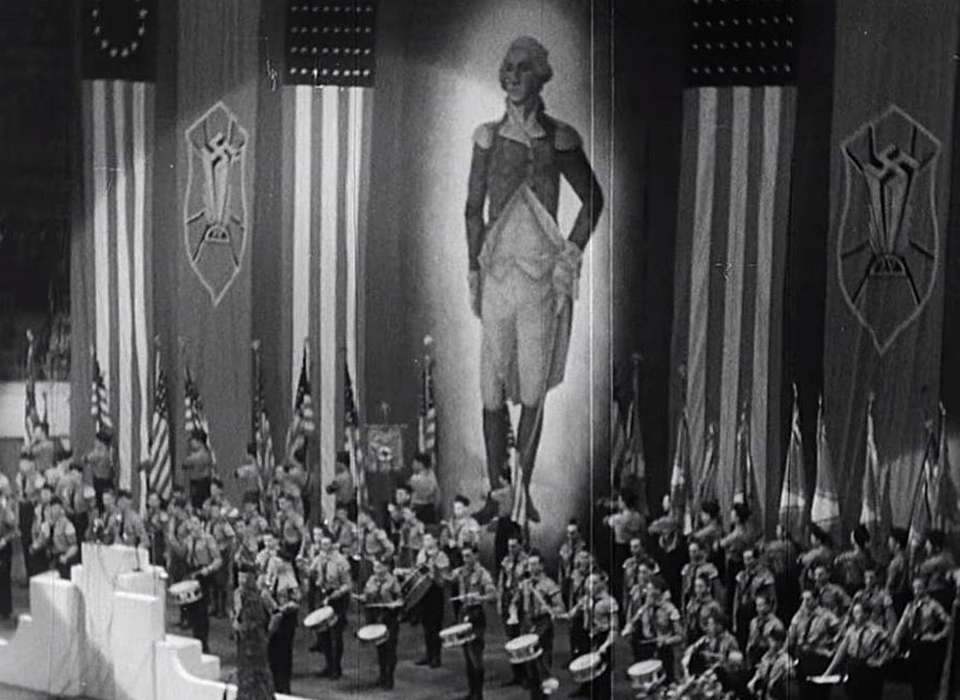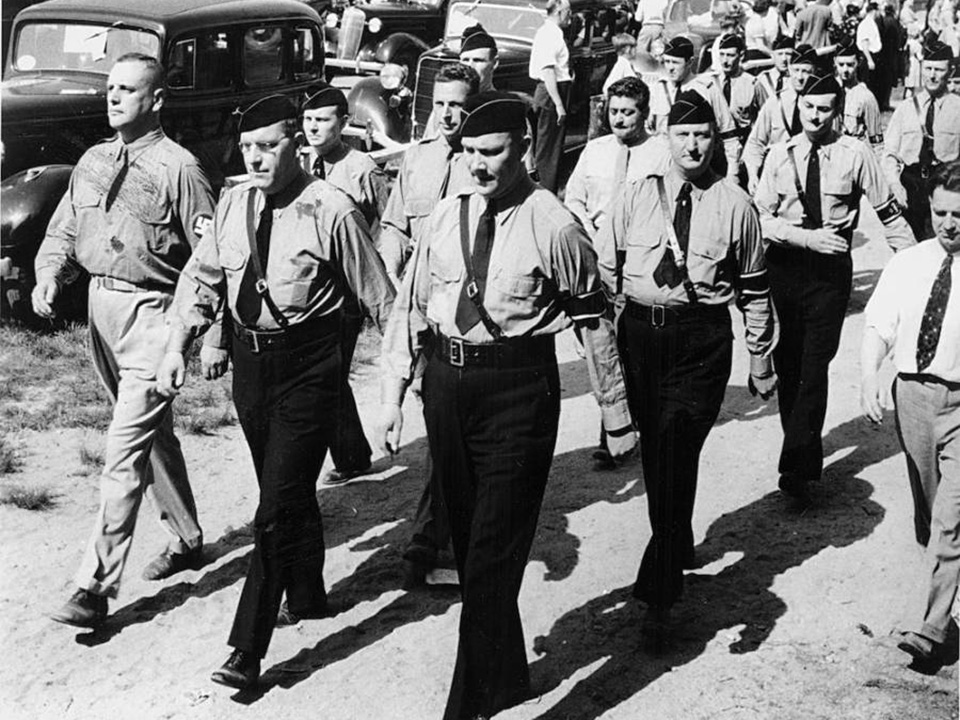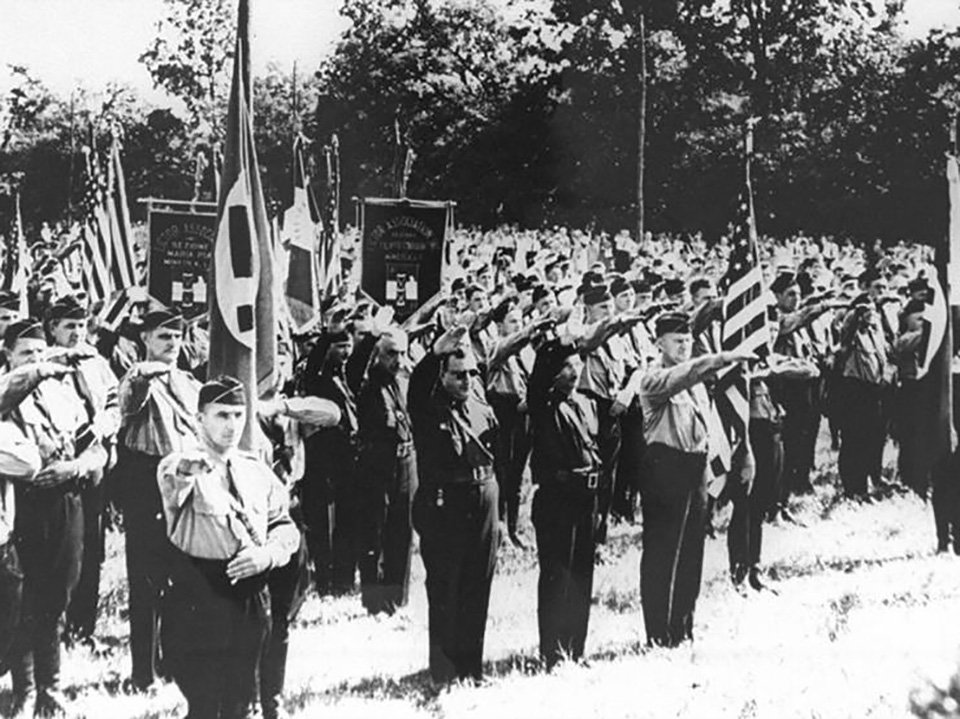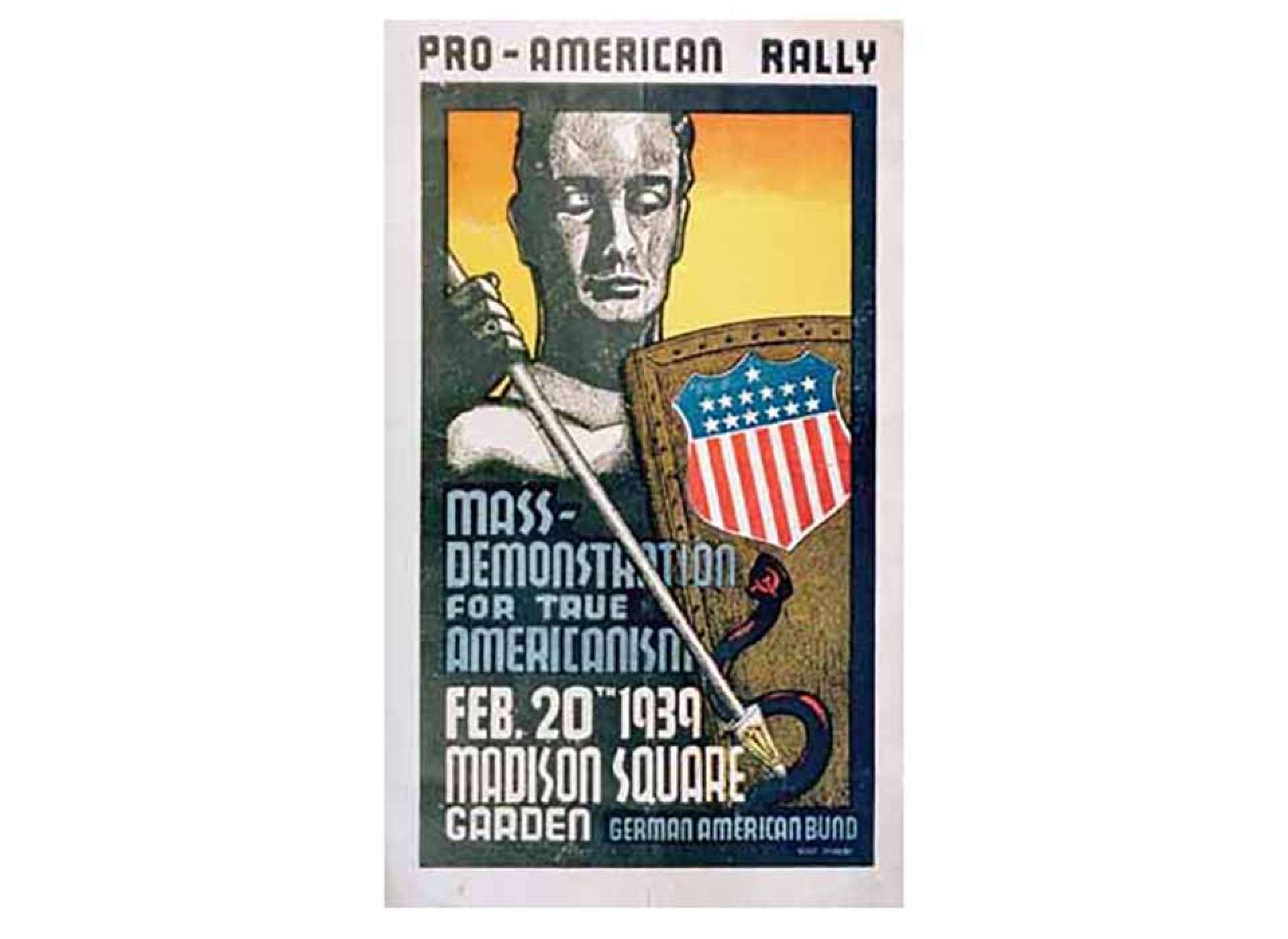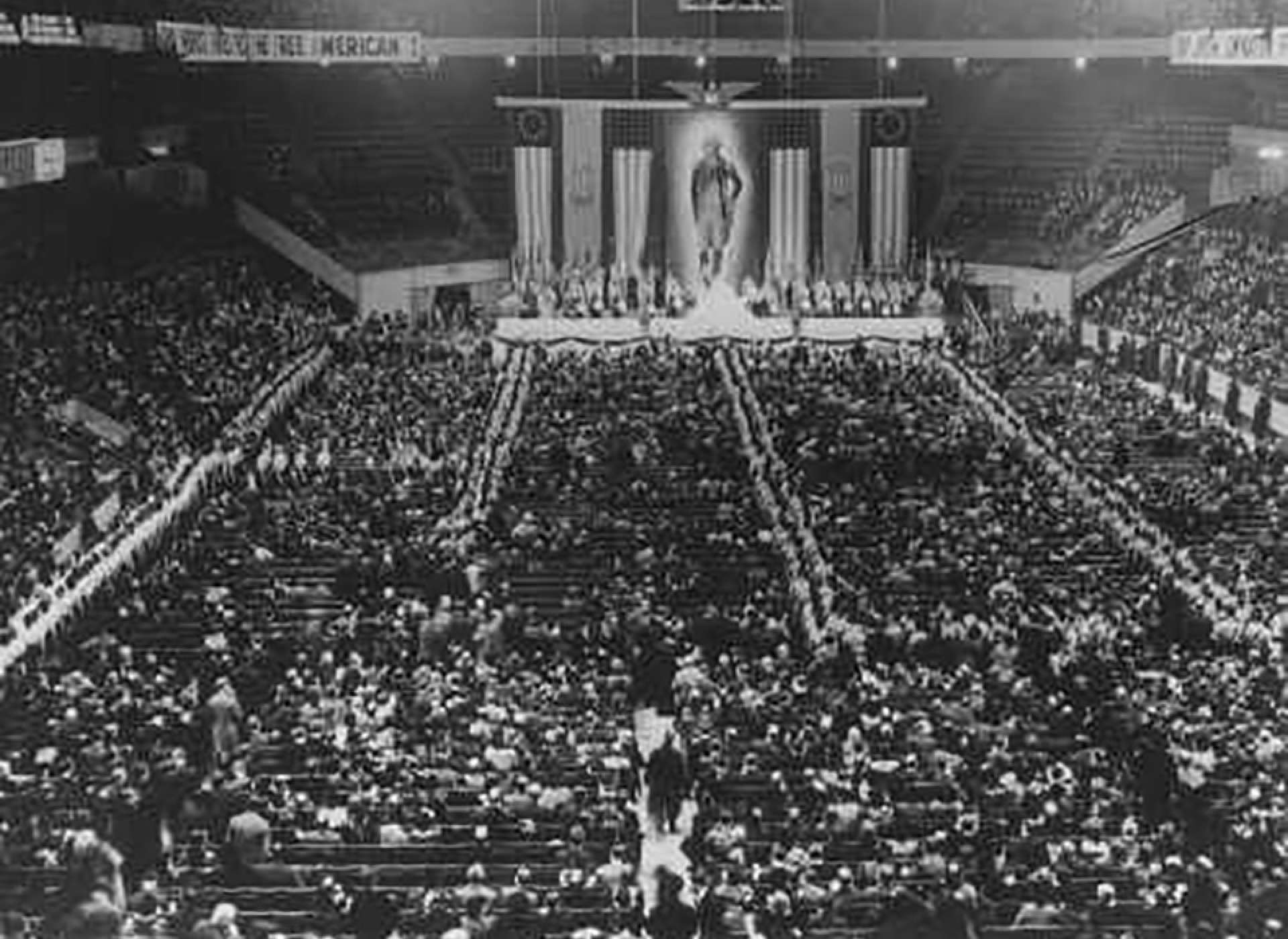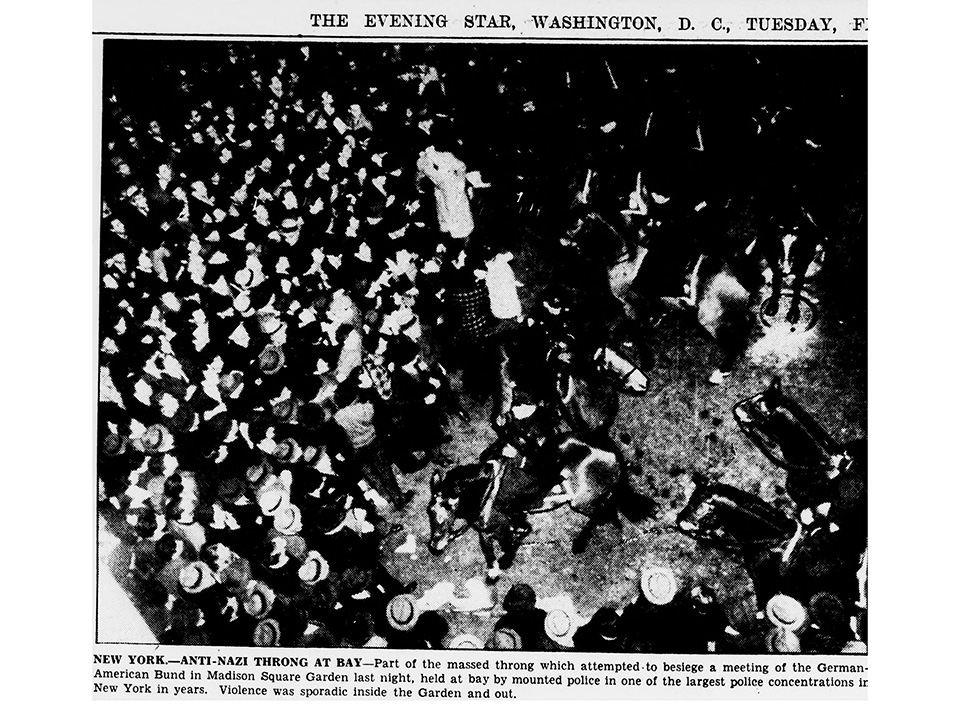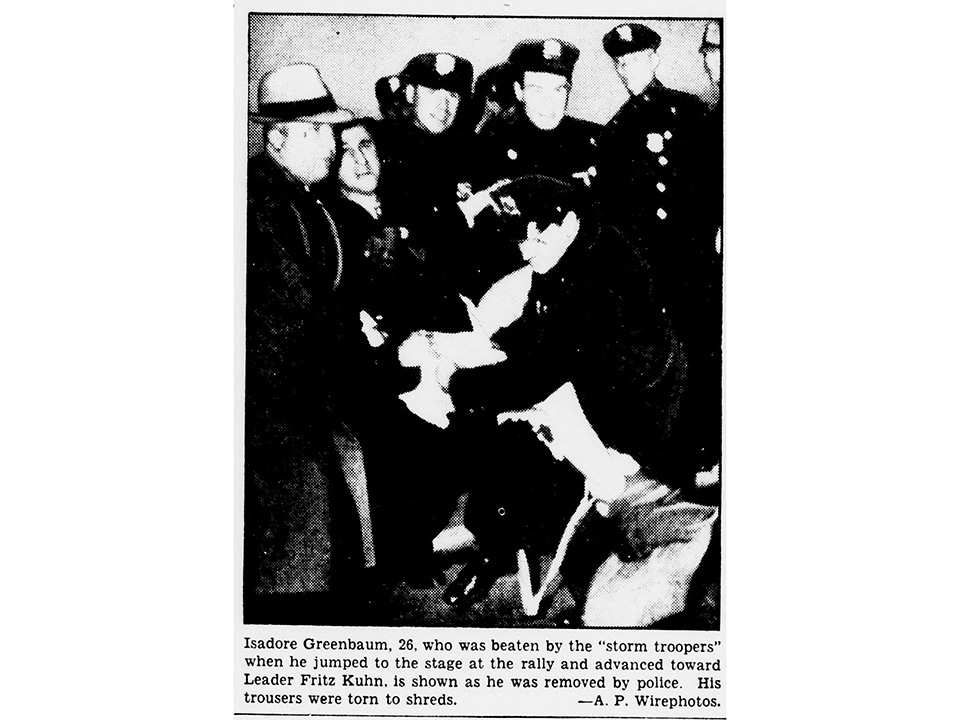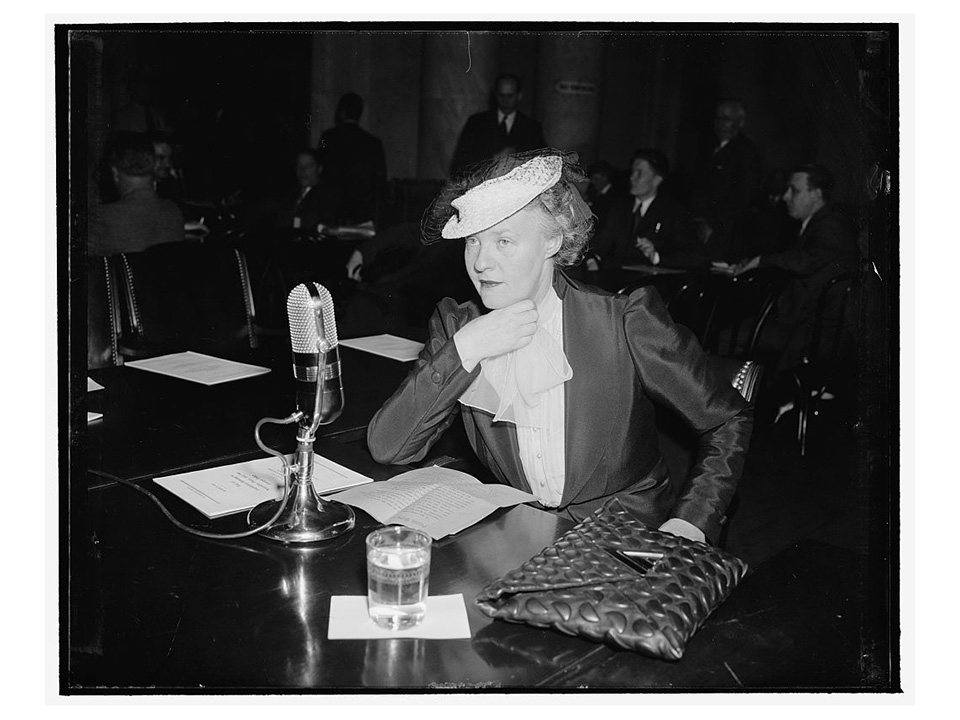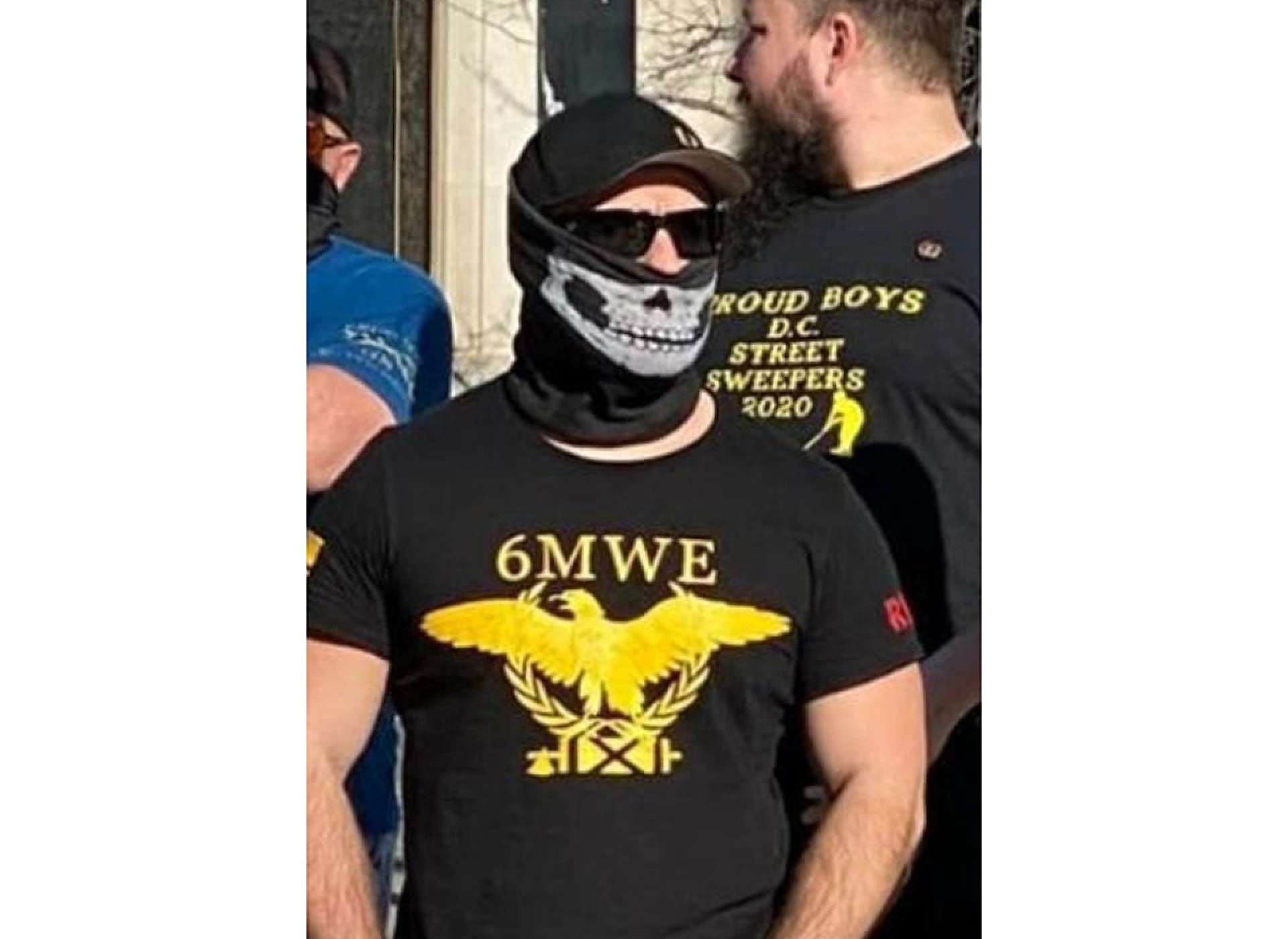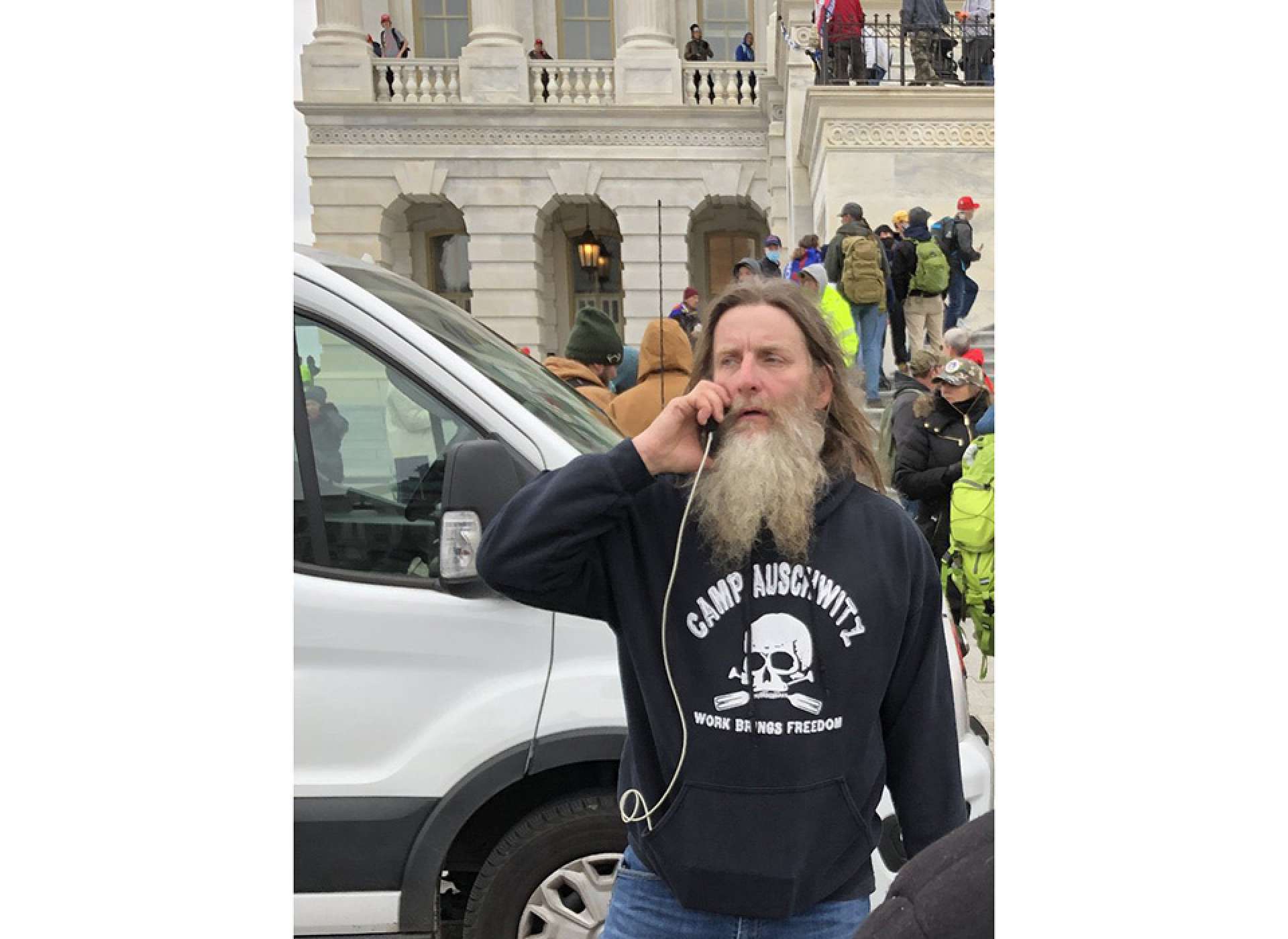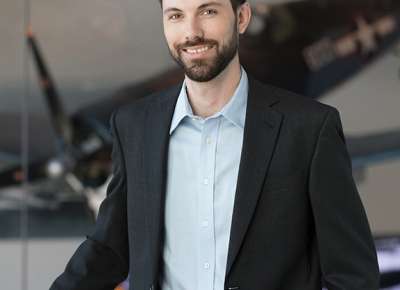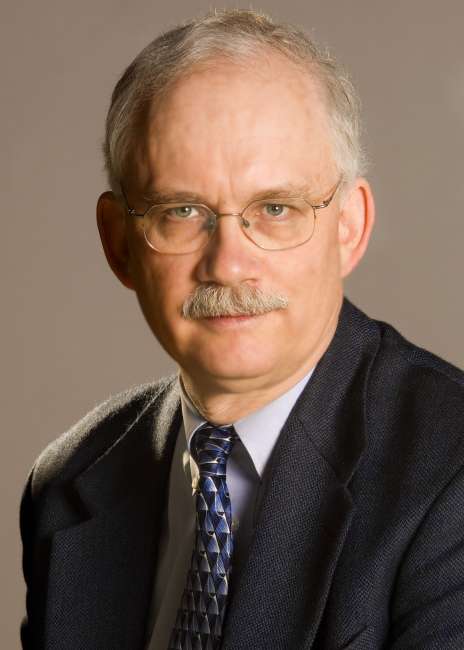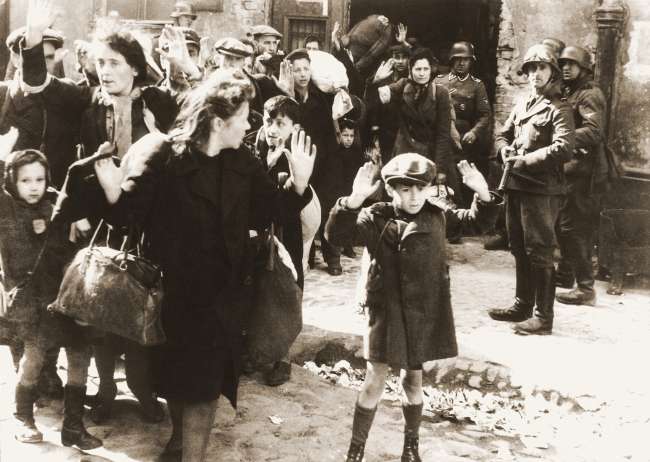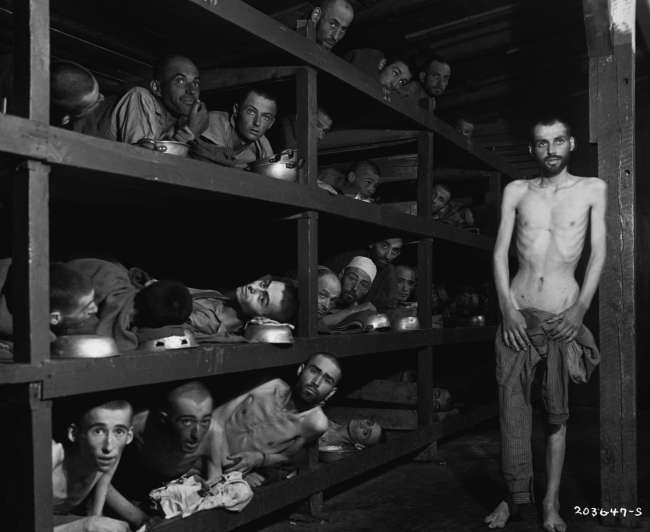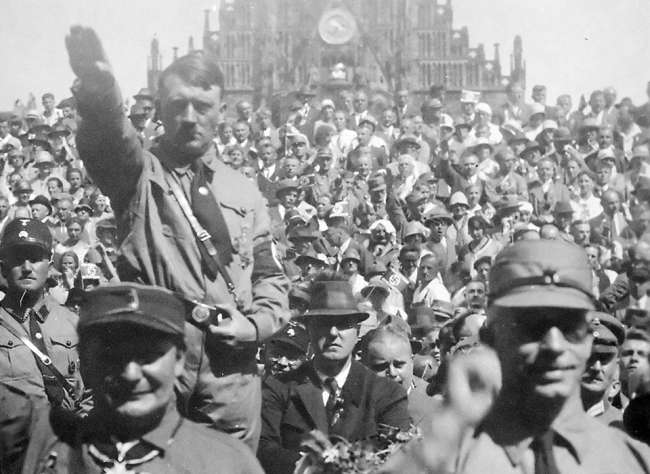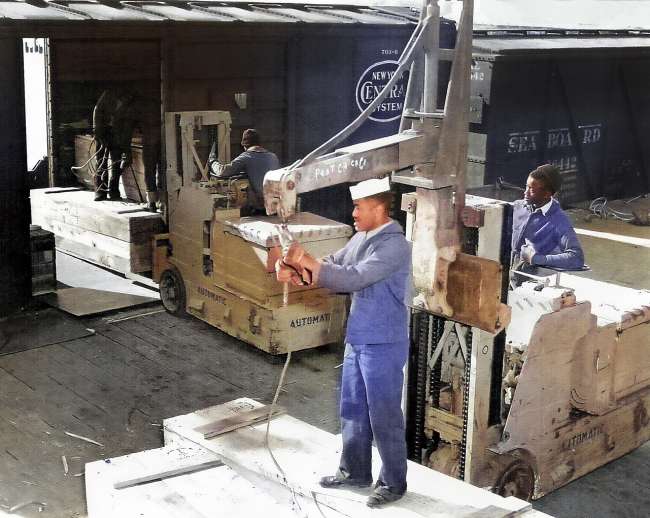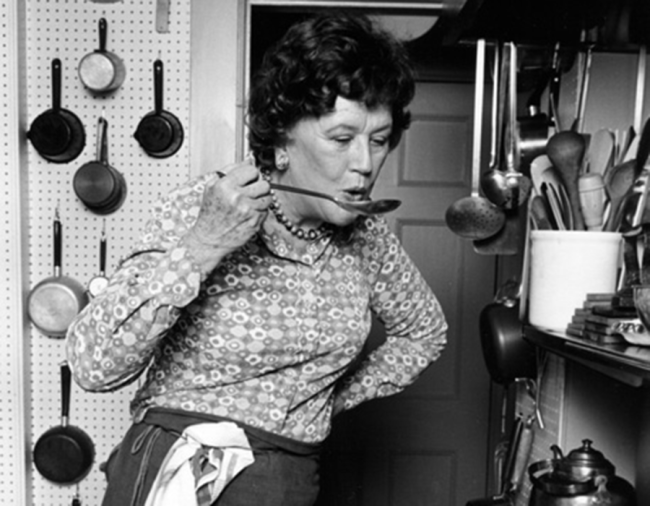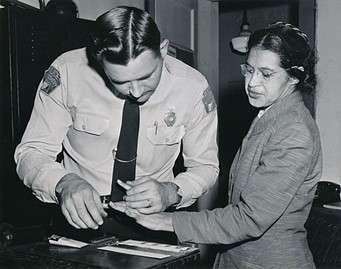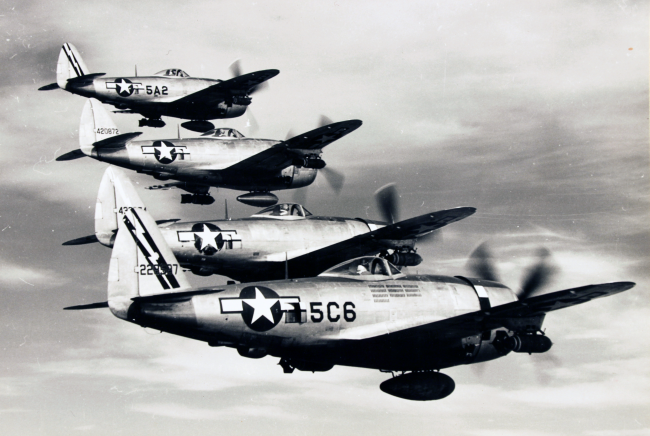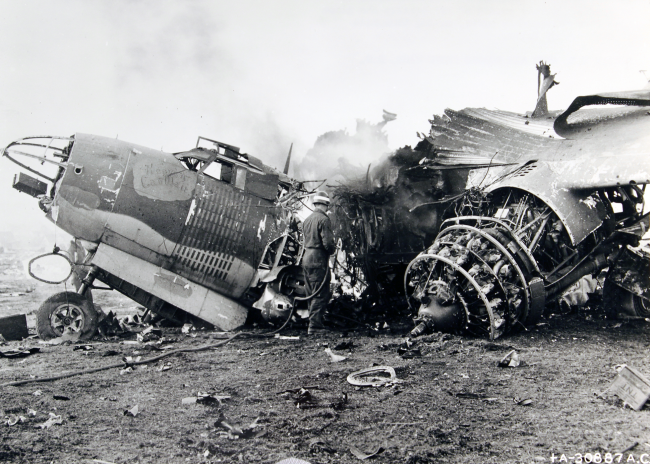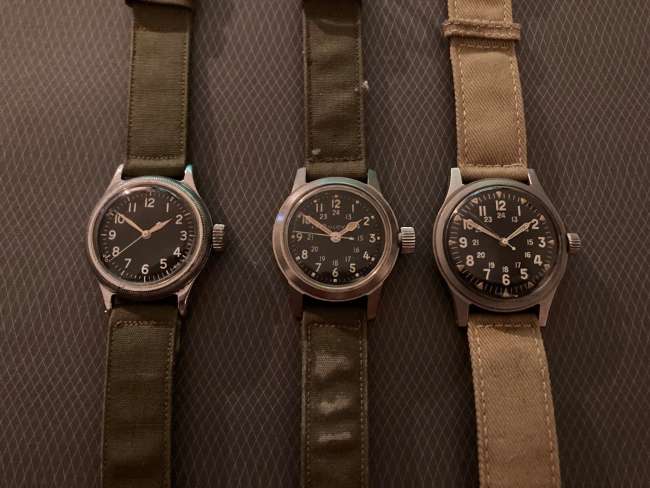Top Image: German American Bund rally New York, Madison Square Garden, February 1939. Image courtesy of the Department of Defense.
The birth of American fascism is nearly impossible to identify within the context of history. The American fascist movement in the 1930s and early 1940s, until recently, was arguably the most organized attempt to bring Nazism to the forefront of American society. While not the earliest pro-Nazi American organization, the German-American Bund was one of the most successful. The Bund was founded in 1936 with a goal to empower German-American citizens to spread Nazi ideology in the United States and to create an American counterpart to the German Nazi Party. The culmination of the German American Bund’s work would be a February 20, 1939 rally at Madison Square Garden in Midtown Manhattan where 22,000 members gathered amidst a flurry of American and Nazi imagery.
Fritz Kuhn, a German veteran of World War I, was the leader (or Bundesfuher) of the German-American Bund. Following World War I, Kuhn immigrated first to Mexico then to the United States where he became a naturalized citizen in 1934. At its height, the Bund had organized 20 youth training camps. Promoted as family-friendly summer camps, Camp Siegfried in Long Island, Camp Hindenberg in Wisconsin, and Deutschhorst Country Club in Pennsylvania were some of the camps devoted to promoting favorable views of Nazi Germany and spreading Nazi ideology in the United States. The camps’ popularity grew rapidly. The New Jersey division of the Bund opened its 100-acre Camp Norland at Sussex Hills in 1937 and the annual German Day festivities at Camp Siegfried in Long Island attracted 40,000 people in 1938.
As the Pro-Nazi and American Fascist movement grew, so did the interest of the American Government. The House Committee on Un-American Activities (HUAC), later made famous by their Cold War Era investigations of suspected communist sympathizers in the United States, was formed in 1938 by Congressman Martin Dies, Jr. to address the German-American Bund, the Bund family summer camps, and pro-Nazi organizations and individuals in the United States. Fritz Kuhn was the first witness called by Dies’ committee. The HUAC did not have the ability to arrest any Bund members. In fact, its conclusions were that the German-American Bund was loud and racist, but fell under the protections of the first amendment. Both the Attorney General and the Federal Bureau of Investigation concluded that the Bund was not a threat to American security. During the hearings, the committee successfully painted the Bund as anti-American. False claims that Khun received orders directly from Adolf Hitler helped to discredit the German-American Bund in the press and in Congress. So much so, that The Washington Post presented Chairman Dies with the “Americanism Award of 1938.”
The height of the German-American Bund’s popularity was marked by the February 1939 rally at Madison Square Garden. Kuhn and other American Nazi leaders called the event a “mass demonstration for true Americanization” and used patriotic imagery alongside Nazi imagery and antisemitic rhetoric. Twenty-two thousand Bund members carried signs and banners with messages such as, “Wake up America! Smash Jewish Communism” and “Stop Jewish Domination of Christian Americans.” Speakers at the rally incorporated antisemitic messages and Nazi propaganda throughout their speeches. Messages which were openly praised by attendants who performed Nazi salutes toward three-story tall banners of George Washington flanked by Nazi swastikas. In Fritz Kuhn’s keynote address, he demanded that “…our government be returned to the American People who founded it.” The Bund’s definition of Americanism was actually a concrete manifestation of German racism and hatred based on racial and religious differences. Hermann Schwinn, the West Coast leader of the Bund, reinforced that idea when he labeled Jews as a threat to American identity and attacked New York City Mayor Fiorello LaGuardia as “the Jew Lumpen LaGuardia.”
-

Poster announcing the “Mass Demonstration for true Americanism.” Image courtesy of The United States Holocaust Memorial Archives.
-

Twenty thousand American-Nazis and their supporters met in Madison Square Garden. Image courtesy of the University of Southern California.
On the day of the rally, Mayor LaGuardia dispatched over 1,000 police officers in anticipation of large protests outside of Madison Square Garden. One-hundred thousand protesters gathered in the streets surrounding the Garden carrying signs with phrases like: “Drive the Nazis out of New York” and “Give me a gas mask, I can’t stand the smell of Nazis.”
Article clipping from The Evening Star. Mounted police hold back a crowd of protesters outside of Madison Square Garden. Image courtesy of Chronicling America.
Protesters clashed with police and German-American Bund members who dared to venture outside of the safety of Bund security. While the rally’s attendees were Bund members and Nazi sympathizers, a few protesters managed to enter the Garden. Isadore Greenbaum, a 26 year old Jewish plumber, stormed the stage and screamed “Down with Hitler!” Greenbaum, who interrupted Fritz Kuhn’s speech, was brutally beaten on stage by Bund storm troopers before police intervened.
Article clipping from The Evening Star. Isadore Greenbaum suffered a broken nose, black eye, and ripped clothing. He later served in the United States Navy and fought against the Nazis in Europe. Image courtesy of Chronicling America.
Dorothy Thompson, a journalist and one of the few female news anchors of her time, also made it into the rally. Thompson worked as the head of the Berlin Bureau of The New York Times where she was given the opportunity to interview Adolf Hitler in 1931. In her book, I Saw Hitler, she was deeply critical of Nazism and described the Führer an “insignificant man.”
“He is formless, almost faceless, a man whose countenance is a caricature, a man whose framework seems cartilaginous, without bones,” she wrote. “He is inconsequent and voluble, ill poised, insecure. He is the very prototype of the Little Man.” … “The Eyes alone are notable. Dark gray and hyperthyroid- they have a peculiar shine which often distinguishes geniuses, alcoholics, and hysterics.”
As the Nazi party consolidated power in Germany, she was the first American journalist to be expelled from the country. During the February Bund Rally in Madison Square Garden, Thompson interrupted a speaker by shouting “Bunk!” She was quickly surrounded by Bund storm troopers and escorted from the building.
Dorothy Thompson supported the repeal of the Neutrality Act and American intervention in Europe. She was surrounded by German American Bund stormtroopers after her interruption. Image courtesy of the Library of Congress.
Within a year of the German-American Bund rally in Madison Square Garden, the organization and their support collapsed. The Nazi invasion of Poland in September 1939, and declarations of war from France and the United Kingdom, eroded support for the American Nazi movement. Shortly after, Kuhn was convicted of embezzlement of funds from the Bund and was sentenced to prison at Sing Sing Correctional Facility. Within a year, every leader of the Bund was interned or jailed as dangerous aliens, and by the end of December 1941, the US Government outlawed the German-American Bund. In 1942, Kuhn’s citizenship was dissolved and he was deported to West Germany in 1945.
The collapse of the German-American Bund was not the end of the pro-Nazi movement in the United States. The America First Committee, whose spokesperson was Charles Lindbergh, was founded in 1940 to support American isolation and Nazi appeasement. Lindbergh crossed the country to hold rallies that blamed Roosevelt and American Jews for pushing the country closer to war. The America First Committee dissolved once the United States entered World War II.
-

Images from the Capitol siege January 2021. American Nazis wearing ‘Camp Auschwitz’ and ‘6MWE’ (6 Million Wasn’t Enough) shirts. Images courtesy of Twitter.
-

Images from the Capitol siege January 2021. American Nazis wearing ‘Camp Auschwitz’ and ‘6MWE’ (6 Million Wasn’t Enough) shirts. Images courtesy of Twitter.
Despite the short-lived histories of these organizations, American society has seen echoes of their ideologies. In 1978, American Nazis attempted to march and rally in Skokie, Illinois. President Trump revived the name “America First” as a slogan for anti-immigrant propaganda. Today, the “Alt-Right” have taken up the mantle of white supremacy and Nazism in the United States. The Unite the Right Rally marched in Charlottesville, Virginia in 2017 chanting Nazi and antisemitic slogans while carrying torches, Nazi flags, and white supremacist imagery. Most recently, at the siege of the US Capital in January 2021, cameras caught Americans in “Camp Auschwitz” and “6MWE” (6 Million Wasn’t Enough) shirts and an abundance of antisemitic, fascist and hate speech, conspiracy theories, and propaganda. The enduring Nazi and white supremist ideologies and rhetoric in the United States remains a lasting and dangerous legacy of the 1939 German-American Bund Rally at Madison Square Garden and the larger American Nazi Movement of the 1930s.
This article was co-authored by Adam Foreman of The National WWII Museum and Dalya Meyer of Tulane University.
Adam Foreman
Adam Foreman is the former Student Programs Specialist at The National WWII Museum.
